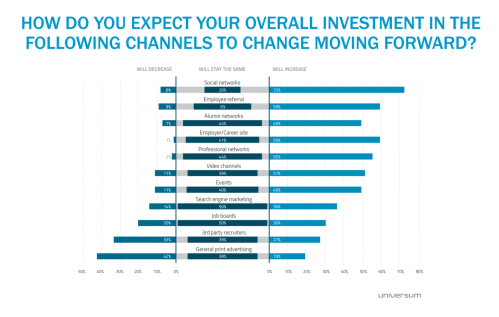
Universum, the global employer branding and market research organization, recently published a new report on the state of employer branding practices. It’s good. If you’re unclear about what employer branding is, this report is for you. If you’re involved – at all – with talent acquisition, this report is for you. If you’ve created your EVP (employee value proposition) and are headed into activation, this report is for you. Because talent is everything in today’s hyper competitive global marketplace, employer branding is becoming a critical part of talent strategy.
The report, Employer Branding Now, is a comprehensive review of what leading organizations around the world are doing to become more successful in connecting with the talent they need. Without giving away the store, the following graph shows how overall investments in recruitment channels are shifting. No surprise that investments in social channels are increasing, along with employee referral programs and alumni networks. On the other side of the coin, it’s probably not surprising that print advertising is sinking rapidly. And while you may have thought job boards were dead, that just isn’t the case. But check out the third-party recruiter channel. Are you surprised?
Food for thought here, I think!
The report is the outcome of a yearly survey of approximately 2,500 employer branding managers from around the world. The respondents represent a wide range of industries, and include 100 of the FORTUNE 500.
The actionable insights that conclude the report give helpful direction to those in the thick of employer branding activation, as well as those just starting to work on their EVP:
-
Create closer alignment between employer brand priorities and talent priorities.
-
Fully leverage the power of EVPs to deliver greater employer brand focus and impact.
-
Balance brand consistency with talent segmentation and local targeting.
-
Invest in quality social media content (no longer a side order, now the meat of the day).
-
Invest in analytics – effective employer brand strategies are increasingly numbers driven.
The report is delivered in a colorful and easy to read eBook format. It’s a good read with attractive and easily understood graphs and data points. You can get it here.
Full disclosure: I chair Universum’s North America Board.













